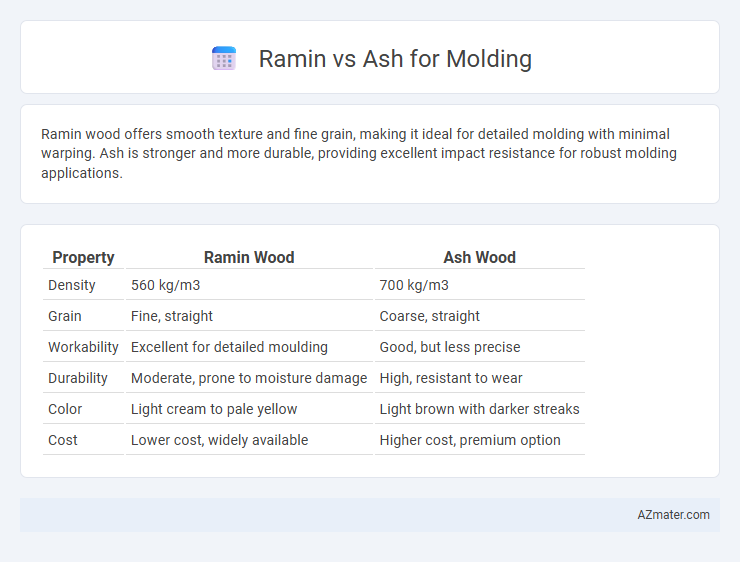Ramin wood offers smooth texture and fine grain, making it ideal for detailed molding with minimal warping. Ash is stronger and more durable, providing excellent impact resistance for robust molding applications.
Table of Comparison
| Property | Ramin Wood | Ash Wood |
|---|---|---|
| Density | 560 kg/m3 | 700 kg/m3 |
| Grain | Fine, straight | Coarse, straight |
| Workability | Excellent for detailed moulding | Good, but less precise |
| Durability | Moderate, prone to moisture damage | High, resistant to wear |
| Color | Light cream to pale yellow | Light brown with darker streaks |
| Cost | Lower cost, widely available | Higher cost, premium option |
Introduction: Ramin vs Ash for Moulding
Ramin and Ash are popular hardwood choices for moulding, each with distinct characteristics. Ramin is a lightweight, pale yellow wood known for its smooth finish and ease of shaping, making it ideal for detailed moulding work. Ash features a pronounced grain with higher durability and strength, offering a robust option for both decorative and structural mouldings.
Overview of Ramin Wood
Ramin wood, sourced primarily from the Shorea species native to Southeast Asia, is widely valued for its fine grain, pale yellow to light brown color, and excellent workability, making it an ideal material for moulding applications. Its lightweight yet dense structure allows for smooth cutting and precise detailing, outperforming heavier hardwoods like ash in intricate designs. The wood's resistance to warping and cracking ensures durability in moulding, providing a stable and aesthetically pleasing finish for interior and furniture trim.
Overview of Ash Wood
Ash wood is a hardwood prized for its light color, straight grain, and excellent workability, making it ideal for moulding applications. Known for its strength and flexibility, ash offers superior shock resistance, which enhances the durability of moulded products. Its natural aesthetic appeal combined with easy finishing options ensures ash remains a popular choice for decorative and structural moulding.
Strength and Durability Comparison
Ramin wood exhibits moderate strength and is known for its fine grain, making it suitable for detailed moulding designs with decent durability in indoor applications. Ash wood surpasses Ramin in strength due to its dense, hard nature, offering superior resistance to impact and wear, which enhances longevity in moulding exposed to physical stress. The durability of Ash moulding is further supported by its natural resistance to splitting and cracking, making it a preferred choice for high-traffic areas where robustness is essential.
Workability and Machinability
Ramin wood offers superior workability compared to ash due to its fine, even texture and softness, making it easier to cut, carve, and shape for intricate mouldings. Ash, while harder and denser, provides excellent machinability with clean cuts and smooth finishes, ideal for durable mouldings requiring structural strength. Selecting between ramin and ash depends on balancing the need for detailed design flexibility with toughness and long-lasting performance in moulding applications.
Aesthetic Differences: Grain, Color, and Appearance
Ramin moulding features a fine, straight grain with a smooth texture, offering a pale cream to light yellow hue that provides a clean, modern aesthetic. Ash moulding presents a more pronounced, open grain pattern with a light brown to beige color, delivering a rustic and warm appearance. These distinct grain and color characteristics make Ramin ideal for sleek, contemporary designs, while Ash suits traditional or natural wood finishes.
Cost and Availability
Ramin offers a lower cost option for moulding compared to Ash, making it attractive for budget-conscious projects. It is widely available in Southeast Asia, ensuring consistent supply and competitive pricing. Ash, while more expensive, provides superior durability and is commonly sourced from North America and Europe, where availability may fluctuate seasonally.
Environmental Impact and Sustainability
Ramin wood, sourced primarily from Southeast Asian rainforests, faces significant sustainability challenges due to overharvesting and illegal logging, leading to habitat loss and biodiversity decline. Ash, on the other hand, often comes from sustainably managed temperate forests, providing a more eco-friendly option with faster growth rates and better carbon sequestration properties. Choosing Ash over Ramin for moulding reduces environmental impact by supporting renewable resources and minimizing deforestation pressure.
Best Use Cases for Each Wood
Ramin wood is ideal for indoor moulding projects due to its smooth texture, fine grain, and easy workability, making it perfect for intricate trims and decorative panels. Ash, known for its strength, durability, and striking grain pattern, is better suited for high-traffic areas or moulding that requires impact resistance, such as staircases and door frames. Choosing Ramin ensures a refined finish suited for interior design, while Ash provides robustness and longevity for structural moulding applications.
Conclusion: Choosing the Right Wood for Moulding
Ramin wood offers a smooth, uniform texture with a pale, consistent color, making it ideal for detailed, painted moulding projects requiring a lightweight, easy-to-work material. Ash wood provides superior hardness and durability with a prominent grain pattern, better suited for stained mouldings that demand long-lasting strength and aesthetic appeal. Selecting between Ramin and Ash depends on whether the priority is a smooth finish for painted surfaces or robust, visually textured moulding for stained applications.

Infographic: Ramin vs Ash for Moulding
 azmater.com
azmater.com